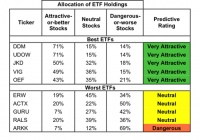Best And Worst Q3’15: Large Cap Blend ETFs, Mutual Funds And Key Holdings
Summary Large Cap Blend style ranks second in Q3’15. Based on an aggregation of ratings of 56 ETFs and 848 mutual funds. DDM is our top-rated Large Cap Blend ETF and CMIIX is our top-rated Large Cap Blend mutual fund. The Large Cap Blend style ranks second out of the 12 fund styles as detailed in our Q3’15 Style Ratings for ETFs and Mutual Funds report. It gets our Attractive rating, which is based on an aggregation of ratings of 56 ETFs and 848 mutual funds in the Large Cap Blend style. See a recap of our Q2’15 Style Ratings here. Figures 1 and 2 show the five best and worst-rated ETFs and mutual funds in the style. Not all Large Cap Blend style ETFs and mutual funds are created the same. The number of holdings varies widely (from 18 to 1334). This variation creates drastically different investment implications and, therefore, ratings. Investors seeking exposure to the Large Cap Blend style should buy one of the Attractive-or-better rated ETFs or mutual funds from Figures 1 and 2. Figure 1: ETFs with the Best & Worst Ratings – Top 5 (click to enlarge) * Best ETFs exclude ETFs with TNAs less than $100 million for inadequate liquidity. Sources: New Constructs, LLC and company filings The Arrow QVM Equity Factor ETF (NYSEARCA: QVM ) is excluded from Figure 1 because its total net assets are below $100 million and do not meet our liquidity minimums. Figure 2: Mutual Funds with the Best & Worst Ratings – Top 5 (click to enlarge) * Best mutual funds exclude funds with TNAs less than $100 million for inadequate liquidity. Sources: New Constructs, LLC and company filings The ProShares Ultra Dow 30 ETF (NYSEARCA: DDM ) is the top-rated Large Cap Blend ETF and the Calvert Large Cap Core Portfolio (MUTF: CMIIX ) is the top-rated Large Cap Blend mutual fund. Both earn our Very Attractive rating. The Ark Innovation ETF (NYSEARCA: ARKK ) is the worst-rated Large Cap Blend ETF and the Virtus Equity Trend Fund (MUTF: VAPAX ) is the worst-rated Large Cap Blend mutual fund. ARKK earns our Dangerous rating and VAPAX earns our Very Dangerous rating. Qualcomm (NASDAQ: QCOM ), is one of our favorite stocks held by Large Cap Blend funds and earns our Very Attractive rating. Since 2010, Qualcomm has grown after-tax profit ( NOPAT ) by an impressive 29% compounded annually. Over this same time frame, Qualcomm’s already top quintile return on invested capital ( ROIC ) has improved from 31% to 54%. In addition, Qualcomm’s NOPAT margin has increased from 23% to 26%. Qualcomm is becoming more efficient and profitable but the stock does not reflect these advancements. At its current price of $62/share, Qualcomm has a price to economic book value ( PEBV ) ratio of 0.8. This ratio implies that the market expects Qualcomm’s NOPAT to permanently decline by 20% from current levels. If Qualcomm can grow NOPAT by just 4% compounded annually over the next five years , the stock is worth $87/share - a 40% upside. Amazon.com (NASDAQ: AMZN ) is one of our least favorite stocks held by Large Cap Blend funds and earns our Dangerous rating. Since peaking in 2010, Amazon’s NOPAT has declined by 28% compounded annually. Its ROIC has fallen from 31% to a bottom quintile 2% over the same time frame. We’ve previously written on Amazon’s free cash flow issues , which have only worsened as Amazon had -$7 billion in free cash flow in 2014. Despite the issues, bulls continue to propel AMZN higher, and it is up 47% year to date, which leaves it significantly overvalued. To justify its current price of $535, Amazon must grow NOPAT by 28% compounded annually over the next 23 years . This scenario also assumes Amazon is able to maintain its pre-tax (NOPBT) margin at 1%, a level it has not been able to maintain in recent years. We think the expectations embedded in AMZN are out of touch with reality. Figures 3 and 4 show the rating landscape of all Large Cap Blend ETFs and mutual funds. Figure 3: Separating the Best ETFs From the Worst Funds (click to enlarge) Sources: New Constructs, LLC and company filings Figure 4: Separating the Best Mutual Funds From the Worst Funds (click to enlarge) Sources: New Constructs, LLC and company filings D isclosure: David Trainer and Kyle Guske II receive no compensation to write about any specific stock, style, style or theme. Disclosure: I/we have no positions in any stocks mentioned, and no plans to initiate any positions within the next 72 hours. (More…) I wrote this article myself, and it expresses my own opinions. I am not receiving compensation for it. I have no business relationship with any company whose stock is mentioned in this article.
